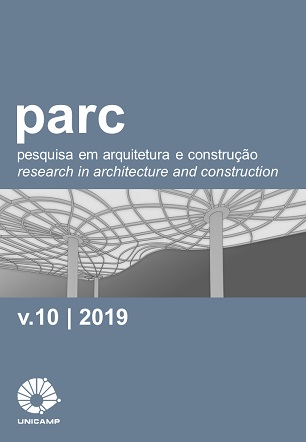Abstract
Generally, multi-storey office buildings count with large glazing surfaces that allow users to enjoy daylighting and natural ventilation and, in addition, provide visual contact with the outdoor environment. However, without an appropriate treatment, these surfaces could influence the buildings thermal loads, and moreover, cause glare in workers. Therefore, a photovoltaic window could be used not only to optimize daylight distribution but to provide energy to artificial lighting when necessary. This research aims to evaluate Organic Photovoltaic (OPV) application in side windows of multi-storey and deep plan office buildings to verify its contribution to the daylight quality of the internal environment. The evaluation was performed in a small-scale model of a generic office room, illuminated by a side window, corresponding to 100% of the North façade. Three window material types were compared under real sky condition in Curitiba-PR: scenario A – 3 mm single glass; scenario B – glass and OPV; and, scenario C – glass with solar film. Besides the reduction in illuminance resulting from scenarios B and C in relation to scenario A, a better daylighting distribution was noticed inside the room and, in addition, in scenario B there is also the possibility of using photovoltaic energy for artificial lighting.
References
ABNT - ASSOCIAÇÃO BRASILEIRA DE NORMAS TÉCNICAS. NBR15215-2: Iluminação natural - Parte 2 - Procedimentos de cálculo para a estimativa da disponibilidade de luz natural. Rio de Janeiro: ABNT, 2005a.
ABNT - ASSOCIAÇÃO BRASILEIRA DE NORMAS TÉCNICAS. NBR 15215-4: Verificação experimental das condições de iluminação interna de edificações – Método de medição. Rio de Janeiro, 2005b.
AGHEMO, C.; PELLEGRINO, A.; LOVERSO, V.R.M. The approach to daylighting by scale models and sun and sky simulators: A case study for different shading systems. Building and Environment, v. 43, p. 917-927, 2008. DOI:http://doi.org/10.1016/j.buildenv.2007.01.020
BAKER, N.; STEEMERS, K. Energy and Environment in Architecture: A technical design guide. Londres: E & FN SPON, 2000.
BASSI, M. D. J. Estudo do efeito do tratamento térmico e aditivo na camada ativa de células solares orgânicas na estrutura de heterojunção em volume. 2017. 94 f.. Dissertação (Mestrado em Física) - Universidade Federal do Paraná, Curitiba.
CHEN, K.-S. et al. Semi-Transparent polymer solar cells with 6% PCE, 25% average visible transmittance and a color rendering index close to 100 for power generating window applications. Energy & Environ. Sci., v. 5, p. 9551, 2012. DOI:http://doi.org/10.1039/c2ee22623e
DING, Z. et al. Spray coated nanowires as transparent electrodes in OPVs for Building Integrated Photovoltaics applications. Solar Energy Materials & Solar Cells, v. 157, p. 305-311, 2016. DOI:http://doi.org/10.1016/j.solmat.2016.05.053
HEE, W. J. et al. The role of window glazing on daylighting and energy saving in buildings. Renew. Sustain. Energy Reviews, v. 42, p. 323-343, 2015. DOI:http://doi.org/10.1016/j.rser.2014.09.020
HOPKINSON, R.G.; PETHERBRIDGE, P.; LONGMORE, J. Iluminação natural. 2.ed. Lisboa: Fundação C. Gulbenkian, 1980.
JØRGENSEN, M. et al. The state of organic solar cells - A meta-analysis. Solar Energy Materials & Solar Cells, v. 119, p. 84–93, 2013. DOI:http://doi.org/10.1016/j.solmat.2013.05.034
LUZ, B. Condução da luz natural por sistemas não convencionais. 2009. 171 f.. Dissertação (Mestrado em Arquitetura e Urbanismo) – Faculdade de Arquitetura e Urbanismo, Universidade de São Paulo, São Paulo.
MARDALJEVIC, J.; CHRISTOFFERSEN, J. A proposal for a European standard for daylight in buildings. In: EUROPEAN LIGHTING CONFERENCE, 12., 2013, Proceedings [...]. Cracóvia: LUX EUROPA., 2013.
MLA style: The Nobel Prize in Chemistry 2000. NobelPrize.org. Nobel Media AB 2017. Disponível em: http://www.nobelprize.org/prizes/chemistry/2000/summary/. Acesso em: 21 jul. 2017.
NREL - NATIONAL RENEWABLE ENERGY LABORATORY. Photovoltaic Research: Organic Photovoltaic Solar Cells. Disponível em: http://www.nrel.gov/pv/organic-photovoltaic-solar-cells.html. Acesso em: 20 de set. 2017.
PAIVA, C. Brasil sai na frente com energia solar OPV. Arcoweb, 2017. Disponível em: http://www.arcoweb.com.br/finestra/tecnologia/tecnologia-brasil-sai-na-frente-com-energia-solar-opv. Acesso em: 21 jul. 2017.
REINHART, C. F. Daylighting Handbook I: Fundamentals, Designing with the Sun. USA, 2014. ISBN: 9780692203637.
SCHMID, A. L. A ideia de conforto: reflexões sobre o ambiente construído. 1. ed. Curitiba: Pacto Ambiental, 2005. 340 p.
SCHMID, A. L.; UEHARA, L. K. Lighting performance of multifunction PV windows: A numeric simulation to explain illuminance distribution and glare control in offices. Energy and Buildings, v. 154, p. 590-605, 2017. DOI:http://doi.org/10.1016/j.enbuild.2017.08.040
SKANDALOS, N.; KARAMANIS, D. PV glazing technologies. Renew. Sustain. Energy Reviews, v. 49, p. 306-322, 2015. DOI:http://doi.org/10.1016/j.rser.2015.04.145
SOUZA, R. V. G.; PEREIRA, F. O. R. First daylight measurement station in the Brazilian territory: analysis of the first two years of data collection. Ambiente Construído, Porto Alegre, v. 4, n. 3, p. 79-94, jul./set. 2004.
YAMAMOTO, N. A. D. Células solares orgânicas baseadas nas estruturas heterojunção em bicamada e heterojunção volume. 2014. 132 f. Tese (Doutorado em Física) - Universidade Federal do Paraná, Curitiba.
YAN, F. et al. Semitransparent OPV modules pass environmental chamber test requirements. Solar Energy Materials and Solar Cells, v. 114, p. 214-218, jul. 2013. DOI:http://doi.org/10.1016/j.solmat.2012.09.031

This work is licensed under a Creative Commons Attribution 4.0 International License.
Copyright (c) 2019 PARC Research in Architecture and Building Construction


